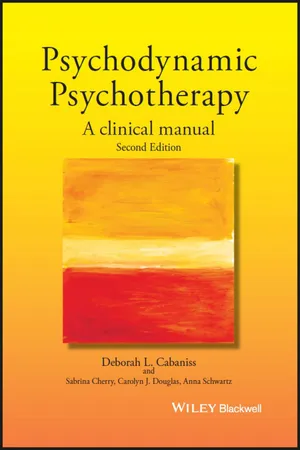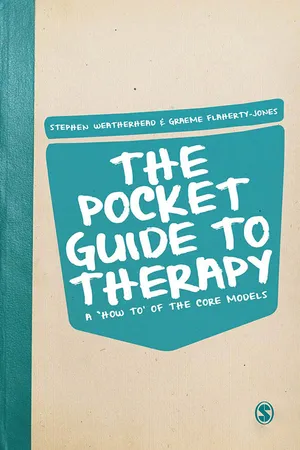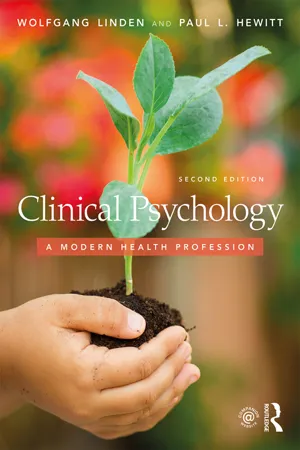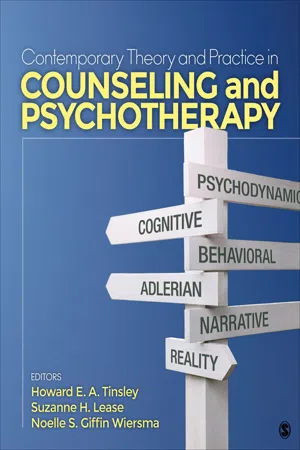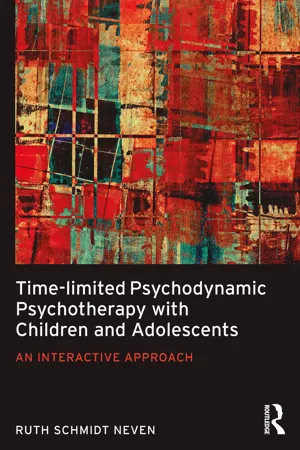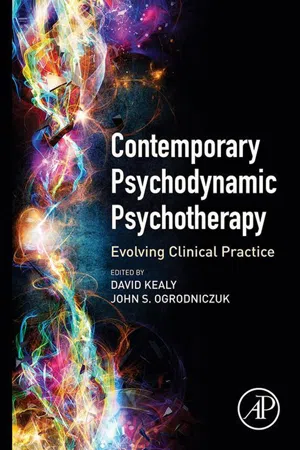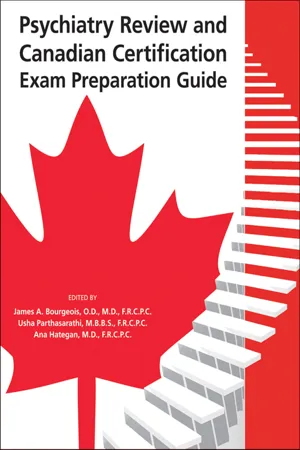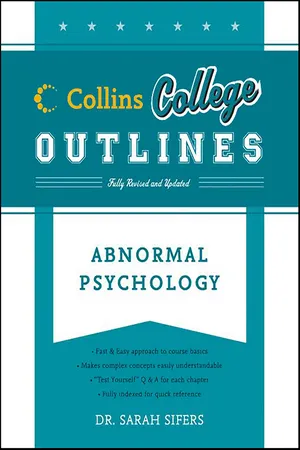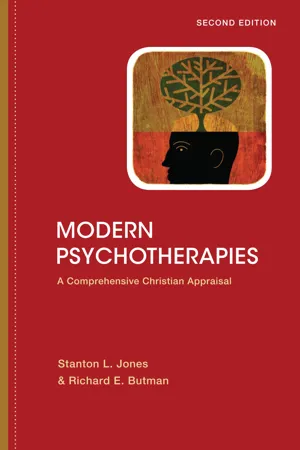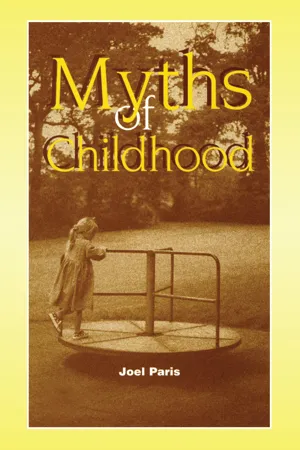Psychology
Psychodynamic Treatments
Psychodynamic treatments are therapeutic approaches that focus on uncovering unconscious conflicts and patterns of behavior. They are based on the principles of psychoanalysis, emphasizing the role of early childhood experiences in shaping personality and behavior. Psychodynamic treatments often involve exploring emotions, thoughts, and past experiences to gain insight into current psychological issues and promote personal growth.
Written by Perlego with AI-assistance
Related key terms
12 Key excerpts on "Psychodynamic Treatments"
- eBook - ePub
Psychodynamic Psychotherapy
A Clinical Manual
- Deborah L. Cabaniss(Author)
- 2016(Publication Date)
- Wiley(Publisher)
Part One: What Is Psychodynamic Psychotherapy?Passage contains an image
1 The Treatment for a Mind in Motion
Key Concepts
Psychodynamics means mind in motion.A psychodynamic frame of reference postulates that dynamic (moving) elements in the unconscious affect conscious thoughts, feelings, and behavior. A psychotherapy that is based on the psychodynamic frame of reference is a psychodynamic psychotherapy.The basic goal of psychodynamic psychotherapy is to help people with problems and patterns that lead to unhappiness and dissatisfaction in life by uncovering unconscious thoughts and feelings and/or directly supporting function in the context of the relationship with the therapist.Both uncovering and supporting techniques are used in almost every psychodynamic psychotherapy.What is Psychodynamic Psychotherapy?
Literally, psychotherapy means treatment for the mind. Psychotherapy has its origins in psychoanalysis – the “talking cure” that was first developed by Sigmund Freud [1]. Consequently, the word psychotherapy has come to refer to a treatment that involves talking. But it's not just any talking – in order to be psychotherapy, the talking has to be:- a treatment
- conducted by a trained professional
- within a set framework
- in order to improve the mental and emotional health of a patient
And what about psychodynamic? You've probably heard this word many times – but what does it mean? Psycho comes from the Greek word psyche, which meant soul but has come to mean mind, and dynamic comes from the Greek word dynamis, which meant power but has come to mean physical force in motion - eBook - ePub
Understanding Therapy
How Different Approaches Solve Real-World Problems
- Rudy Nydegger(Author)
- 2019(Publication Date)
- Greenwood(Publisher)
From this beginning, psychodynamic psychological theories and therapies started to emerge, and all of them (starting with Freud’s psychoanalysis) were committed to understanding the dynamic psyche as a system with structure and energy; some of the most important elements of this system were found in a subconscious that was not only dynamic and active but also determinative of thoughts, feelings, and behaviors at the conscious level of functioning. Therefore, these underlying dynamics could result in conflicts or other maladaptive processes that would interfere with the normal functioning of the whole system, and that “therapy” or treatment for maladaptive psychological functioning must address the underlying, subconscious conflicts or problems if any true treatment or improvement of the whole functioning system could be achieved. Therapies that are based on psychodynamic theories usually rely on techniques like dream analysis, free association, interpretation, and working through painful memories and issues to arrive at an insight into and understanding of the nature of the underlying conflicts and buried memories so that true resolution of the difficulties arising from these underlying issues could be realized.Key Individuals and Their Contributions
Some of the basic principles of psychodynamic types of psychotherapy include the following:- An emphasis on the fundamental importance of intrapsychic (inside the mind) and unconscious conflicts and their role in shaping psychological development.
- Identifying and working with the psychological defenses that people use to avoid dealing with the painful memories and conflicts that are the basis of the symptoms that they experience.
- A belief that most psychological difficulties are based on experiences from a person’s childhood.
- The idea that the psychic representations of our experiences (including those from childhood) are organized around social and interpersonal relations.
- The conviction that psychological issues and dynamics will emerge in psychoanalytic therapy symbolically through the client–therapist relationship in elements like “transference” (the way a patient reacts emotionally toward their therapist because the therapist symbolically represents someone emotionally important in the patient’s background) or “countertransference,” where the therapist reacts to a client in ways symbolically related to someone important in their own psychological history.
- The use of free association as a primary method for uncovering unconscious conflicts and problems; this is where the patient just relates whatever is going on in their mind without editing or thinking about it.
- eBook - ePub
The Pocket Guide to Therapy
A ′How to′of the Core Models
- Stephen Weatherhead, Graeme Flaherty-Jones, Stephen Weatherhead, Graeme Flaherty-Jones(Authors)
- 2011(Publication Date)
- SAGE Publications Ltd(Publisher)
It is not possible to squeeze all the different theoretical schools of psychodynamic therapy into a pocket guide such as this. If you want to read more, see Lemma (2006) for an introductory summary, where, among other theories, you will see discussion of object relations theory. This approach, influenced by the work of British psychologists Ronald Fairbairn and Melanie Klein, focuses on relationships and how we are shaped by our early relationships.The terms ‘psychodynamic’ and ‘psychoanalytic’ are often used interchangeably to refer to these approaches; however, throughout this chapter we will use the term ‘psychodynamic’. There is a general consensus that the key concepts of the psychodynamic model are:- the therapeutic relationship
- boundaries
- transference
- countertransference
- interpretations.
The fundamental commonality that all psychodynamic therapies share is the importance placed on the internal world and the unconscious (things out of our conscious awareness). The process of becoming aware of aspects of ourselves that were previously out of conscious awareness is called ‘insight’, and you may often hear psychodynamic therapy referred to as an ‘insight-orientated’ therapy.Freud initially proposed a model of the mind which identified three levels of consciousness, including consciousness (what we are aware of in the here and now), the preconscious (what is just out of our conscious awareness but that we can recall) and the unconscious (what is out of awareness).Psychodynamic therapy is based on the assumption that the symptoms a person presents with, such as anxiety or depression, are meaningful and are the expression of feelings that are out of conscious awareness. These feelings are out of conscious awareness because they are too painful to acknowledge and are in conflict with another perceived need. Therefore, expressing the feelings will result in negative consequences. Such painful hidden feelings are generally thought to have their origins in early life experiences.We all develop ways to protect ourselves from painful feelings. These protective processes are also known as ‘defences’; they include ways of seeing, thinking, feeling or behaving that serve to protect us from emotional pain or conflict. Given their protective role, it is important that the reasons for their existence are considered before offering therapy. - eBook - ePub
Clinical Psychology
A Modern Health Profession
- Wolfgang Linden, Paul L. Hewitt, Don Saklofske(Authors)
- 2018(Publication Date)
- Routledge(Publisher)
These characteristics interact, and, at times, conflict or are at odds with one another. That is, there is a dynamic interplay among the components of personality, and, in order to understand the person and his or her difficulties, the clinical psychologist needs to understand that dynamic interplay. More generally, psychodynamic models and/or therapies focus on the inner motives or drivers of behavior, that are usually thought to be outside of the person’s awareness, and result in overt and covert behavior, or in the case of psychopathology, signs and symptoms of maladjustment. Psychoanalysis refers to one specific yet comprehensive psychodynamic theoretical perspective developed initially by Sigmund Freud that has been revised, often extensively, by many other psychoanalytic theorists. To make matters more complicated, the main treatment approach that Freud developed (and, again, that others revised), is also called psychoanalysis. We will use the term “classical psychoanalysis” in this chapter to refer to traditional psychoanalytic treatment that was developed by Freud. Below you will find a brief overview of treatments that derive from psychoanalytic thought. These types of treatments will be discussed in more detail later on in the chapter. Classical psychoanalysis is a psychodynamic treatment focused on inborn, internal, and biological drives that are unconscious and primarily sexual in nature. Later in his career, Freud suggested that unconscious aggressive drives can also be important in influencing behavior (Sharf, 2000). It is thought that these drives influence personality development, both normal and pathological - Howard E. A. Tinsley, Suzanne H. Lease, Noelle S. Giffin Wiersma(Authors)
- 2015(Publication Date)
- SAGE Publications, Inc(Publisher)
psychoanalysis.Over the course of the next century and beyond, Freud’s theory that a form of talking therapy can be effective in ameliorating the psychiatric problems that troubled people served as the inspiration for the full range of contemporary approaches to counseling and psychotherapy. Psychoanalysis, itself, also underwent many modifications in theory and technique since Freud’s original work, resulting in the development of contemporary psychodynamic psychotherapy.Principles of Contemporary Psychodynamic Psychotherapy
Basic Elements of the Psychoanalytic Model of the Mind
Psychodynamic psychotherapy is based on the psychoanalytic model of the mind. This model leads naturally to a model of psychopathology, and to a theory of treatment, both of which are necessary for any psychotherapy. As we will see below, four basic, widely recognized psychoanalytic models of the mind have developed over the years. These models of the mind share four basic elements: the unconscious; motivation and conflict; development and the role of childhood; and fantasy, conflict, and compromise.The unconscious
A fundamental tenet held by all practitioners of psychodynamic psychotherapy is that much of what shapes mental life is unconscious. Overt behaviors and symptoms reflect unconscious processes that include wishes, feelings, thoughts, attitudes, and memories (see Figure 5.1 ). These mental experiences coexist in the unconscious mind at various levels of integration. Wishes are organized into fantasies that patients tell themselves about their experiences in the world. Fantasies are organized into a life story- eBook - ePub
Time-limited Psychodynamic Psychotherapy with Children and Adolescents
An interactive approach
- Ruth Schmidt Neven(Author)
- 2016(Publication Date)
- Routledge(Publisher)
Given the limitations of purely behavioural and symptom-based approaches in work with children and young people, it is timely to reconsider what a psychodynamic approach has to offer. The questions that need to be asked, however, refer to the ways in which the psychodynamic approach can be redefined and recalibrated for our changing times. This would necessarily include how a psychodynamic perspective of time-limited psychotherapy can resonate with the challenges of the contemporary emotional and social landscape of childhood, adolescence and parenting.In this book, the term psychodynamic is used rather than psychoanalytic, which is considered to be limiting in the sense that it endorses mainly long-term treatment and has the potential to give rise to confusion and misunderstanding. The term psychodynamic is perceived as incorporating psychoanalytic ideas and theory as well as concepts related to attachment, family systems and organisational dynamics.Above all, the term psychodynamic is used to refer to a way of understanding the meaning of human behaviour which is at all times perceived as essentially relational, dynamic and not static.Challenging articles of faith
The pursuit of a refreshed vision for psychodynamic therapy for children and young people, whilst acknowledging the contribution of long-established psychoanalytic theory and practice, nevertheless necessitates a critical examination of this theory and practice and its historical biases. Psychotherapy trainings together with many other areas of professional endeavour that prepare students for practice, pay tribute to the works and wisdom of their founders. As the sociologist Thomas Scheff (2003) explains, each culture (from which the scientific community is not immune) generates and reflects a variety of assumptions that are never fully declared or critically discussed, thus contributing to the maintenance of the status quo. These ruling assumptions are understood as 'tropes' which in turn give rise to a variety of linguistic and mental routines. Within child psychotherapy training as well as adult psychoanalytic training, similar sacrosanct doctrines prevail in which there is an adherence to the theories and life works of many remarkable and innovative pioneers who have made enormous contributions to our understanding of human psychology. The problem however is, that there is a serious risk that these theories, so illuminating in their time, have now become embedded and repeated as articles of faith in the various training schools. This has the potential to create an environment in which it is difficult to examine these theories critically in the light of changing circumstances, as well as for new ideas and theory to flourish. - eBook - ePub
Contemporary Psychodynamic Psychotherapy
Evolving Clinical Practice
- David Kealy, John S. Ogrodniczuk(Authors)
- 2019(Publication Date)
- Academic Press(Publisher)
While attention to unconscious mental life remains central to psychoanalytic or psychodynamic psychotherapy, much of our experience is available and accessible for introspection, reflection, and conscious decision making. As Wachtel (2005) has noted, consciousness is better conceptualized as a matter of degree of accessibility and articulation than as a discrete division between conscious and unconscious. Another tenet of the psychodynamic approach is that while some mental processes happen to be outside of our awareness, people are also motivated to push threatening thoughts or feelings from awareness. This process is the idea of defense or defense mechanism. This concept of defense is generally supported in the empirical literature examining narratives of adults, psychophysiological data, and neuroscience data and is generally well accepted (Cramer, 2000). A third tenet central of psychodynamic theory is that of a developmental perspective wherein childhood relationships with caregivers are seen as playing a role in shaping current relationships. This is not to imply a linear relationship or a critical period between early experience and later development. Psychodynamic theory, consistent with a developmental psychopathology perspective, is probabilistic rather than deterministic. From this perspective, childhood experiences, in concert with genetic (what Freud called constitutional) factors, are considered with regard to their influence on one’s internal experience of oneself as well as one’s overt behavior. A fourth tenet of a psychodynamic perspective emphasizes the importance of subjective experience or individual or personal meaning of events. Psychodynamic theorists and clinicians are interested in the patient’s phenomenological experience, that is, how the patient experiences himself or herself, important others, and the world in general - James A. Bourgeois, Usha Parthasarathi, Ana Hategan(Authors)
- 2012(Publication Date)
- American Psychiatric Association Publishing(Publisher)
Psychodynamic psychotherapy may take months or years. Typically, a longer-term treatment is open ended; no termination date is set in the beginning of treatment. The length of treatment depends on the number of conflict areas to be addressed and the course of the treatment. Psychotherapy sessions are usually held one, two, or three times a week, although treatments once a week is the norm. The frequent meetings permit a more detailed exploration of the patient’s inner life and a fuller development of the transference. The frequent meetings also support the patient during the treatment process.The Technique of Psychodynamic Psychotherapy
Behavioural change occurs in psychodynamic psychotherapy primarily through two processes of treatment: understanding the cognitive and affective patterns derived from childhood (defence mechanisms) and understanding the conflicted relationship(s) one had with one’s childhood significant figures as they are reexperienced in the doctor-patient relationship (transference). The recovery and understanding of these feelings and perceptions are the focus of treatment. The treatment setting is designed to facilitate the emergence of these patterns in a way that allows them to be analyzed rather than being confused with the reality of the doctor-patient relationship or being dismissed as trivial.Primary to the success of psychoanalytically oriented psychotherapy is the need for the patient to feel engaged in the work and to trust the relationship with the therapist. This therapeutic alliance is built on the reality-based elements of the treatment, such as the mutual working together toward a common goal and the consistency and reliability of the therapist (Bruch 1974 ). Only in contrast to a good therapeutic alliance can the patient view the transference feelings and experience the distortion that the transference reveals.The clinician empathically hears what the patient says in order to understand what an experience means to the patient (Fromm-Reichman 1950). What the patient is able to bring into focus is what is dealt with in the treatment (Coleman 1968- No longer available |Learn more
- Sarah Sifers(Author)
- 2011(Publication Date)
- Collins Reference(Publisher)
2. Be wary of therapists who urge you to behave in ways that go against your religious, moral, or ethical standards. For example, a therapist who makes sexual advances of any sort is behaving unprofes-sionally and destroying any possible effectiveness of the treatment.3. Try not to hold back information from your therapist. 4. Do not hesitate to ask questions or to raise objections to what a therapist is doing or proposing.THERAPIES OF THE PSYCHODYNAMIC PERSPECTIVE
Because the underlying philosophy of the psychodynamic perspective and the earliest techniques used were set by Freud, orthodox Freudian psychoanalysis is described first. Then changes introduced following Freud, with an emphasis on modern psychoanalytic practice, are set forth.Basic Characteristics of the Psychodynamic Therapies
In general, all the psychodynamic therapies are insight therapies and are global in their expected outcome. Psychodynamic therapists are more inclined than others to see therapy as an art in which the therapist’s intuitions and theories are important ingredients. The principal activity of the client is talking with the therapist. The therapist, through such techniques as free association and dream analysis, leads the client into verbalizations and emotional reactions that will reveal his or her early life history and uncover unconscious or less conscious feelings and attitudes toward principal family members and toward the client himself or herself. The therapist will be less active than the patient, suggesting broader or more significant meaning to what the client has reported and occasionally commenting on the client’s behavior in therapy. Modern psychodynamic therapists are likely to be more active than orthodox Freudian analysts and are also likely to go beyond interpretations of what the client has reported in order to give direction and advice, particularly on current interpersonal difficulties. They also are more likely to accept supplementary assistance from the use of some biogenic methods, particularly the use of pharmaceutical drugs to lighten depression or anxiety. - eBook - ePub
Christian Association for Psychological Studies Books
A Comprehensive Christian Appraisal
- Stanton L. Jones, Richard E. Butman(Authors)
- 2012(Publication Date)
- IVP Academic(Publisher)
Contemporary Psychodynamic Psychotherapies Michael W. Mangis, Stanton L. Jones and Richard E. ButmanT he contemporary psychodynamic psychotherapies are those schools of thought influenced by Freud and classic psychoanalysis that have evolved substantially beyond orthodox analytic thought. Christians have not been alone in being dissatisfied with the deterministic and mechanistic assumptions of the Freudian system, which paint a picture of humans as isolated beings irrationally driven by biological, primitive drives welling up within them, their personalities molded by discrete psychic structures interacting mechanically and unconsciously to achieve compromises leading to drive gratification. Christians have also not been alone in seeing the rich possibilities of a system that seeks to understand the profound impact of early relationships on our character, the mysterious way in which we are shaped by unconscious processes, and the pervasive presence of psychological conflict in our lives.In fact, many argue that Freud himself led the way in attempting to resolve some of the mechanistic and deterministic problems in his own model. The focus of much of Freud’s later work was on the ego as presented in The Ego and the Id (1923/1961). In his earliest theorizing, when he was working from his seduction theory, Freud emphasized interpersonal environment as the cause of pathology. He quickly moved away from that position to a more “scientific” view where psychological development was seen as an almost entirely internal and self-contained process. The person was seen as controlled by biological instincts and drives, and by the actions and fantasies associated with those drives. The ego had little true efficacy. But in The Ego and the Id - eBook - ePub
- Joel Paris(Author)
- 2013(Publication Date)
- Routledge(Publisher)
The most effective factors in psychotherapy derive from a strong therapeutic alliance and from a problem-solving approach. Evidently, the conduct of psychotherapy is more commonsensical and less complicated than it seems. Thus, a researcher’s advice to a practitioner might parallel Spock’s (1946) famous advice to mothers: You know more than you think you know. □ Research on the Exploration of Childhood Experience in Therapy The influence of the psychoanalytic movement led generations of therapists to believe that the key to successful therapy involves the accurate reconstruction of childhood experiences. Interpretation is a term describing this process: explaining the present through events in the past, and demonstrating these connections to patients. Freud (1900/1953), semijocularly quoting scripture, proclaimed that psychoanalysis depends on the principle that the truth shall make you free. The entire apparatus of psychoanalytic therapy, free association, dream interpretation, analysis of resistance, and removal of repression, was designed to parallel the methods of archaeology, digging up buried evidence of a long lost past. Different versions of psychodynamic theory lead to different approaches to the exploration of the past. For example, some therapists (e.g., Herman, 1992) focus on exploring memories of childhood trauma. Others (Bowlby, 1973 ; Kohut, 1970) tend to explore memories of emotional neglect, reconstructing family climates that failed to meet basic needs. No matter what the focus, we need to know whether the exploration of childhood actually makes a difference in results. In an era of evidence-based practice, it is insufficient to justify theories through clinical experience or to convince one’s colleagues through charisma and rhetoric. More and more, practitioners demand to see evidence in support of theory - eBook - ePub
- Bruce Carruth(Author)
- 2013(Publication Date)
- Routledge(Publisher)
Someone who has been subjected to chronic stress or trauma may have unevenness in her psychological development, including a limited repertoire of more primitive and rigid defenses. She may have impairments in psychological functioning or ego defense that result in difficulty distinguishing psychological boundaries, misinterpreting the actions/statements of others, difficulty feeling safe and trusting of self and others, desperately needing and simultaneously fearing closeness. A few examples are as follows: The person who projects uncomfortable emotions and thoughts onto others, the person who “shuts down” during or withdraws from situations in which she perceives conflict, the person who gets very close to others quickly but rejects them equally fast when they disappoint her. Such a person is likely to become quickly attached to her counselor yet will be at risk of being easily hurt, disappointed, enraged when the counselor is not meeting her needs as she wants, and therefore at risk of leaving treatment prematurely. During stressful times, we all rely more heavily on primitive defenses to protect ourselves, as primitive defenses are generally more global in their ability to block out painful affect and stimuli.Psychodynamic psychotherapists expect clients to bring their preferred ego defenses and resistance into the treatment setting. In fact, resistance is always present in the treatment setting as it “defends the status quo,” and protects the individual from painful affect. From the psychodynamic point of view, treatment becomes the arena in which the resistance appears and then gets worked through (Greenson, R., 1967, p. 36). In psychodynamic psychotherapies one goal is to uncover (help both the client and counselor to see) the ego defenses and understand the resistance. The resistance must enter the treatment to be explored. The goal is “to uncover how the patient resists, what he is resisting and why he does so” (Greenson, R., 1967, p. 36). The goal of treatment is to raise the unconscious into consciousness. Once conscious, there is opportunity to work through what was previously inaccessible to the client. Even when conscious, defenses are by generally ego-syntonic, in other words, they “feel right” or in accordance with the individual’s vision of herself. Successful treatment renders these processes ego-dystonic, or in conflict with one’s self-image, opening them to change. Through treatment, clients develop an expanded and more flexible repertoire of ego defenses and coping skills, and adapt higher-level defenses. For instance, rather than dealing with painful affect through isolation, the client will be able to feel her anger, shame and sadness while talking about her trauma. In addition, she will utilize compartmentalization at times when it is not appropriate to be re-experiencing her trauma, so that she can go about her daily life.
Index pages curate the most relevant extracts from our library of academic textbooks. They’ve been created using an in-house natural language model (NLM), each adding context and meaning to key research topics.
